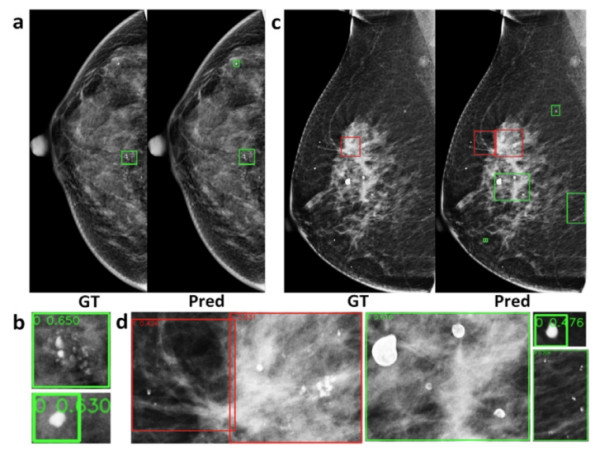FAYETTEVILLE, GA, UNITED STATES, May 13, 2025 /EINPresswire.com/ -- This study introduces a deep-learning system for rapid, automated detection and classification of tiny calcium deposits (microcalcifications) in mammograms to aid early breast cancer diagnosis. Leveraging a multi-center dataset of 4,810 biopsy-confirmed mammograms, our pipeline uses a Faster RCNN model with a feature-pyramid backbone to detect and classify microcalcifications—the pipeline requires no hand-tuned rules and provides both the overall cancer risk and highlighted lesion regions in seconds per image. On unseen test data, it achieved overall classification accuracy of 72% for discriminating between benign and malignant breasts and 78% sensitivity of malignant breast cancer prediction, marking a significant step toward AI-assisted, cost-effective breast-cancer screening that can run on standard radiology workstations.
Each year, millions of women undergo mammography to screen for breast cancer, yet tiny calcium specks—known as microcalcifications—often evade detection or are misread, leading to delayed diagnoses or unnecessary biopsies. Conventional computer-aided tools rely on hand-crafted rules and struggle with the sheer variety of imaging devices and lesion patterns.
In a recent study led by Dr. Ke-Da Yu from Fudan University Shanghai Cancer Center, a novel deep-learning approach that automatically finds and classifies microcalcifications across different machines and patient populations was developed—bringing both accuracy and consistency to breast-cancer screening.
“Microcalcifications can be just a few pixels wide. Hence, spotting them amid normal tissue is like finding a needle in a haystack,” explains Dr. Yu. “We wanted a system that adapts to any mammogram and never overlooks early warning signs.”
The team’s innovation rests on two key advances:
1. Adaptive, multi-scale detection: By integrating a faster region-based convolutional neural network (R-CNN) model with a feature-pyramid network (FPN), the pipeline fuses features at multiple resolutions—enabling it to localize both coarse clusters and individual specks without any manually tuned thresholds.
2. Robust, multi-center training: Trained on 4,810 biopsy-confirmed mammograms (6,663 lesions evenly split between benign and malignant) from three hospitals, the system automatically standardizes each image, so it works seamlessly across different scanners and clinical settings.
In blind testing, the pipeline processed each mammogram, achieving approximately 75% overall accuracy at the microcalcification-lesion level with 76% sensitivity for malignant lesions and about 72% accuracy at the breast level.
“This solution can be deployed directly on standard radiology workstations,” adds Dr. Yu. “By pre-marking suspicious regions on each mammogram, it enables radiologists to quickly focus on areas of concern, significantly reducing both missed diagnoses and unnecessary biopsies—thereby easing patient discomfort and lowering healthcare costs.”
The research team has open-sourced the code, and their next steps will focus on integrating the system into clinical workflows, with the aim of offering a reliable AI-driven tool for more widespread breast-cancer screening.
The study was published in Fundamental Research.
References
DOI
10.1016/j.fmre.2023.04.018
Original Source URL
https://doi.org/10.1016/j.fmre.2023.04.018
Funding Information
This study acknowledge the support by the National Natural Science Foundation of China ( 82072916 , 82071878 , U2001209 , 61902076 , and 61772137 ), the 2018 Shanghai Youth Excellent Academic Leader, the Fudan ZHUOSHI Project, Chinese Young Breast Experts Research project ( CYBER-2021-A01 ), Shanghai Engineering Research Center of Artificial Intelligence Technology for Tumor Diseases, Xuhui District Artificial Intelligence Medical Hospital Cooperation Project ( 2020-008 ), Shanghai Science and Technology Foundation ( 19DZ1930502 ), Clinical Research Plan of SHDC ( SHDC2020CR2008A ), and Natural Science Foundation of Shanghai ( 21ZR1406600 ).
Lucy Wang
BioDesign Research
email us here
Legal Disclaimer:
EIN Presswire provides this news content "as is" without warranty of any kind. We do not accept any responsibility or liability for the accuracy, content, images, videos, licenses, completeness, legality, or reliability of the information contained in this article. If you have any complaints or copyright issues related to this article, kindly contact the author above.
![]()





